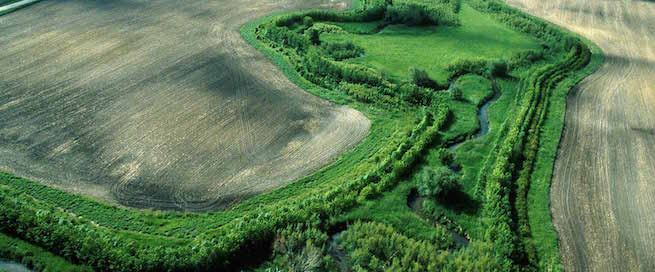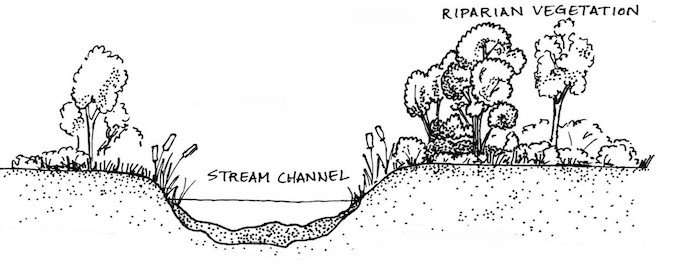Streamside buffers are an important part of stream ecosystems because they decrease pollution, control erosion, and provide wildlife habitat. Also called riparian buffers, streamside buffers are naturally occurring vegetated areas that run alongside streams and other aquatic systems such as lakes, ponds, and wetlands.
In regions where land is used for agriculture and livestock, nitrogen and phosphorus pollution from fertilizers and animal waste are a major concern for water quality. Once the pollutants enter the aquatic environment, tiny organisms such as algae instantly feed on the fertilizer. The quick increase in production uses up lots, if not all, of the dissolved oxygen in the water, causing eutrophication. By absorbing up to 90% of the nutrients before they enter the water, streamside buffers protect aquatic systems from runoff pollution.
Streamside buffers also protect water quality by stabilizing the banks of the stream, which helps secure sediments and decrease turbidity. When natural vegetation buffers around streams are removed, erosion occurs. Stream erosion is problematic for many reasons, erosion causes sedimentation and siltation downstream, erosion degrades wildlife habitat, and eroded banks are unable to control flooding. Streamside buffers help control erosion in two ways: below the surface of the water, the roots from vegetation stabilize stream banks and above the surface, the vegetation lessens the energy from the flowing water.
For wildlife, streamside buffers are important because they provide habitat and food. Habitat loss is a major problem for numerous species of animals including amphibians, birds, fish, and mammals. Streamside buffers are a sanctuary for animals because they provide cover, water, and food, all of which are necessary for survival. When properly implemented, the buffers can increase biodiversity and act as a corridor by connecting fragmented habitat. For aquatic species, streamside buffers are important because they provide shade, which decreases water temperatures and increases, dissolved oxygen in the water.
Because streamside buffers are so important for aquatic ecosystems, they must be implemented and managed thoughtfully to provide the most benefit. Numerous studies have been conducted on which plants are most appropriate, how wide the buffer should be, and the angle of the buffer along the stream bank. Because part of TLC’s mission is to safeguard clean water, streamside buffers are an important aspect of all conservation easements. With each easement, the streamside buffer is carefully considered by defining the width of the buffer, which activities can and cannot happen within the buffer, and creating a legally recorded map of the buffer. TLC works carefully with their properties and landowners to protect surface water, natural water courses, lakes, ponds, marshes, subsurface water, and any other water bodies from pollution.
References
Gilliam, J. W., Osmond, D. L., Evans, R. O. (1997). Selected Agricultural Best Management Practices to Control Nitrogen in the Neuse River Basin. North Carolina Research Service Technical Bulletin 311, North Carolina State University, Raleigh, NC. http://www.soil.ncsu.edu/publications/BMPs/
Hawes, E., Smith, M. (2005). Riparian Buffer Zones: Functions and Recommended Widths. Yale School of Forestry & Environmental Studies. http://eightmileriver.org/resources/digital_library/appendicies/09c3_Riparian%20Buffer%20Science_YALE.pdf
Klapproth, J. C. (2009). Understanding the Science Behind Riparian Forest Buffers: Effects on Plant & Animal Communities. Virginia Cooperative Extension, Virginia Tech. http://pubs.ext.vt.edu/420/420-152/420-152.html


